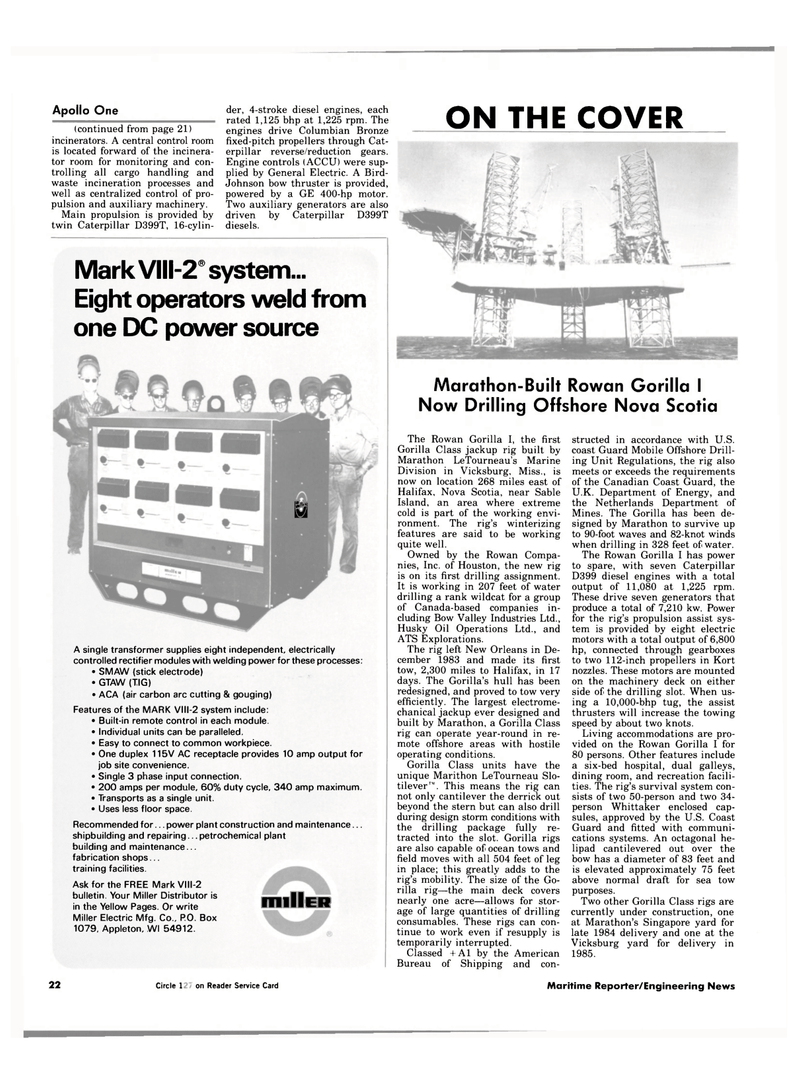
Page 20: of Maritime Reporter Magazine (April 1984)
Read this page in Pdf, Flash or Html5 edition of April 1984 Maritime Reporter Magazine
ON THE COVER
Marathon-Built Rowan Gorilla I
Now Drilling Offshore Nova Scotia
Apollo One (continued from page 21) incinerators. A central control room is located forward of the incinera- tor room for monitoring and con- trolling all cargo handling and waste incineration processes and well as centralized control of pro- pulsion and auxiliary machinery.
Main propulsion is provided by twin Caterpillar D399T, 16-cylin- der, 4-stroke diesel engines, each rated 1,125 bhp at 1,225 rpm. The engines drive Columbian Bronze fixed-pitch propellers through Cat- erpillar reverse/reduction gears.
Engine controls (ACCU) were sup- plied by General Electric. A Bird-
Johnson bow thruster is provided, powered by a GE 400-hp motor.
Two auxiliary generators are also driven by Caterpillar D399T diesels.
Pa M
The Rowan Gorilla I, the first
Gorilla Class jackup rig built by
Marathon LeTourneau's Marine
Division in Vicksburg, Miss., is now on location 268 miles east of
Halifax, Nova Scotia, near Sable
Island, an area where extreme cold is part of the working envi- ronment. The rig's winterizing features are said to be working quite well.
Owned by the Rowan Compa- nies, Inc. of Houston, the new rig is on its first drilling assignment.
It is working in 207 feet of water drilling a rank wildcat for a group of Canada-based companies in- cluding Bow Valley Industries Ltd.,
Husky Oil Operations Ltd., and
ATS Explorations.
The rig left New Orleans in De- cember 1983 and made its first tow, 2,300 miles to Halifax, in 17 days. The Gorilla's hull has been redesigned, and proved to tow very efficiently. The largest electrome- chanical jackup ever designed and built by Marathon, a Gorilla Class rig can operate year-round in re- mote offshore areas with hostile operating conditions.
Gorilla Class units have the unique Marithon LeTourneau Slo- tilever"'. This means the rig can not only cantilever the derrick out beyond the stern but can also drill during design storm conditions with the drilling package fully re- tracted into the slot. Gorilla rigs are also capable of ocean tows and field moves with all 504 feet of leg in place; this greatly adds to the rig's mobility. The size of the Go- rilla rig—the main deck covers nearly one acre—allows for stor- age of large quantities of drilling consumables. These rigs can con- tinue to work even if resupply is temporarily interrupted.
Classed +A1 by the American
Bureau of Shipping and con- structed in accordance with U.S. coast Guard Mobile Offshore Drill- ing Unit Regulations, the rig also meets or exceeds the requirements of the Canadian Coast Guard, the
U.K. Department of Energy, and the Netherlands Department of
Mines. The Gorilla has been de- signed by Marathon to survive up to 90-foot waves and 82-knot winds when drilling in 328 feet of water.
The Rowan Gorilla I has power to spare, with seven Caterpillar
D399 diesel engines with a total output of 11,080 at 1,225 rpm.
These drive seven generators that produce a total of 7,210 kw. Power for the rig's propulsion assist sys- tem is provided by eight electric motors with a total output of 6,800 hp, connected through gearboxes to two 112-inch propellers in Kort nozzles. These motors are mounted on the machinery deck on either side of the drilling slot. When us- ing a 10,000-bhp tug, the assist thrusters will increase the towing speed by about two knots.
Living accommodations are pro- vided on the Rowan Gorilla I for 80 persons. Other features include a six-bed hospital, dual galleys, dining room, and recreation facili- ties. The rig's survival system con- sists of two 50-person and two 34- person Whittaker enclosed cap- sules, approved by the U.S. Coast
Guard and fitted with communi- cations systems. An octagonal he- lipad cantilevered out over the bow has a diameter of 83 feet and is elevated approximately 75 feet above normal draft for sea tow purposes.
Two other Gorilla Class rigs are currently under construction, one at Marathon's Singapore yard for late 1984 delivery and one at the
Vicksburg yard for delivery in 1985.
Mark VII1-2 system-
Eight operators weld from one DC power source
A single transformer supplies eight independent, electrically controlled rectifier modules with welding power for these processes: • SMAW (stick electrode) • GTAW (TIG) • ACA (air carbon arc cutting & gouging)
Features of the MARK VIII-2 system include: • Built-in remote control in each module. • Individual units can be paralleled. • Easy to connect to common workpiece. • One duplex 115V AC receptacle provides 10 amp output for job site convenience. • Single 3 phase input connection. • 200 amps per module, 60% duty cycle, 340 amp maximum. • Transports as a single unit. • Uses less floor space.
Recommended for... power plant construction and maintenance... shipbuilding and repairing...petrochemical plant building and maintenance... fabrication shops... training facilities.
Ask for the FREE Mark VIII-2 bulletin. Your Miller Distributor is in the Yellow Pages. Or write
Miller Electric Mfg. Co., P.O. Box 1079, Appleton, Wl 54912.
HIIIIER 22 Circle 218 on Reader Service Card Maritime Reporter/Engineering News

 19
19

 21
21
